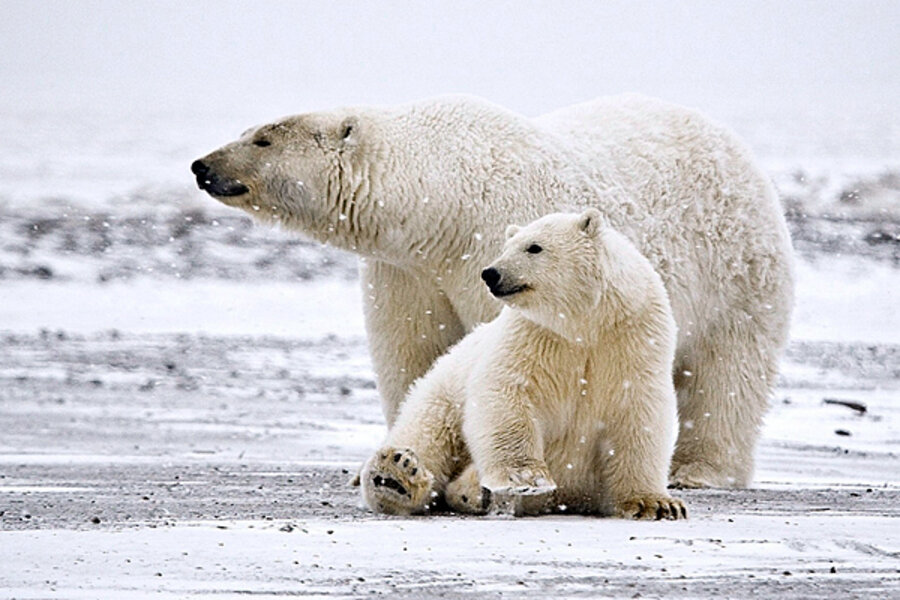Where polar bears might go if climate change doesn't slow
Loading...
By midcentury, the northern islands of Canada and the north coast of Greenland may represent the only remaining region in the Arctic where polar bears and the marine animals that sustain them can survive if greenhouse-gas emissions continue to climb at anywhere near their current levels.
That's the scenario a team of US and Canadian scientists came up with in looking at the prospects for Arctic habitats if greenhouse-gas emissions follow a business-as-usual track through the end of the century.
The research, outlined at a briefing Thursday during the American Geophysical Union's fall meeting in San Francisco, stands as a bookend to a study published Thursday in the journal Nature, which suggests that sustainable populations of the bears could be preserved around the Arctic if greenhouse-gas emissions are aggressively curbed and if traditional wildlife-management approaches are rigorously applied.
The work in Nature "is talking about what happens if we act to reduce our greenhouse-gas emissions," said Stephanie Pfirman, a marine geologist at Barnard College in New York as well as a researcher with the Lamont-Doherty Earth Observatory in Palisades, N.Y. In the work she and her colleagues presented Thursday in San Francisco, "we're providing a scenario on what a new Arctic reality might be if we don't" reduce emissions.
The team's curiosity was piqued by projections for summer sea-ice minimums in the Arctic Ocean if greenhouse-gas concentrations keep rising under the Intergovernmental Panel on Climate Change's "business as usual" emissions scenario.
Summer sea ice is vital to a range of Arctic marine and land animals, and its annual summer melt-off is projected to increase dramatically as the climate warms. As minimum extant declines, polar bears would lose the floating platforms they have come to rely on for hunting and breeding.
The climate simulation that the team used, assuming a business-as-usual emissions scenario, indicated that at the height of the summer melt-back, the sea-ice extent could fall from nearly 2 million square miles today to perhaps 100,000 square miles between 2040 and 2050. And it would hover around that level through the end of the century.
If that ice is scattered in random patches throughout the Arctic Ocean, polar-bear populations could be expected to vanish, either through loss of habitat or from interbreeding with other, related bears.
But if that ice collected in one general area, the team posited, it might be enough to provide a last "refuge" for many of the inhabitants of the Arctic's coastal marine ecosystem.
Using historic observations of ice movement in the Arctic Ocean, as well as simulations to provide insights into possible future behavior of winds and currents, the team found that during the winter, enough ice would pile up against northern Canada's archipelago and northern Greenland to ensure sufficient ice cover during the melt season.
The cover would probably be enough to provide the platforms the bears need.
But conditions might not be sufficient to ensure the long-term survival of polar-bear prey, such as ring seals.
The seals must build snow caves on the ice to hide from polar bears, give birth to their young, and provide shelter for the pups as they grow, notes Brendan Kelly, a biologist with the National Oceanic and Atmospheric Administration's National Marine Mammal Laboratory in Juneau, Alaska, and another member of the team reporting results at Thursday's meeting.
The team's projections indicate that during the second half of the century, too little snow will be available to the seals. A warmer global climate would bring more precipitation, with more snow falling on the sea ice in winter. But the warmth also would delay the return of the ice after the summer melt-back.
Snow levels on the ice in winter would be "substantially less" than the amounts needed for snow caves "because the late freeze-up effect really dominates," Dr. Kelly says.
Identifying a likely refuge for polar bears and many other important species along the Arctic coast is an important step toward crafting plans to preserve a sustainable population there, Kelly says.
But such plans also would require a level of advanced planning unfamiliar to the conservation community, he adds.
"In my experience with management of wildlife populations, you're lucky if you've got a 10-year plan. Having a 100-year plan for a completely different habitat, that's new territory for resource managers," he says.





